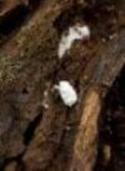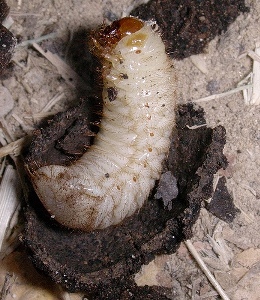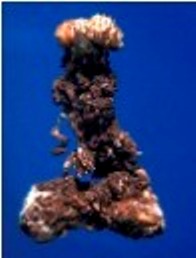Habitat
Where do I live and what do I do?
 Cordyceps subsessilis lives
in a habitat common to most fungi alike to itself. It has
been found in organic soils or decaying wood. In general,
it will live wherever it can find its host and ideal living
conditions. The host of Cordyceps subsessilis is
a beetle of the family Coleoptera It takes
exteremely precise conditions for the actual fruiting body form
of Cordyceps subsessilis to be produced. In most
cases, Cordyceps subsessilis is actually in its
anamorph form as Tolypocladium inflatum. As
Tolypocladium inflatum, the fungus still lives in the soil
but instead of having a fruiting body, it is just a mold.
When looking for Cordyceps subsessilis, it might
actually be a little less substantial in its anamorph mold form.
Cordyceps subsessilis lives
in a habitat common to most fungi alike to itself. It has
been found in organic soils or decaying wood. In general,
it will live wherever it can find its host and ideal living
conditions. The host of Cordyceps subsessilis is
a beetle of the family Coleoptera It takes
exteremely precise conditions for the actual fruiting body form
of Cordyceps subsessilis to be produced. In most
cases, Cordyceps subsessilis is actually in its
anamorph form as Tolypocladium inflatum. As
Tolypocladium inflatum, the fungus still lives in the soil
but instead of having a fruiting body, it is just a mold.
When looking for Cordyceps subsessilis, it might
actually be a little less substantial in its anamorph mold form.
Other organisms that occur in this
habitat would be sapro phytic fungi looking to break down the decaying wood and
other fungi living on nutrients in the soil or other decaying organisms.
Plants that may be nearby would include various grasses, trees, shrubs, and even
angiosperms. Animals that would live nearby would be some annelids,
reptiles, amphibians, birds, mammals, and especially arthropods of the
Coleoptera family. All these organisms that live around Cordyceps
subsessilis bring a lot to the organism's habitat. Herbivores that
eat the plants around the area also excrete the plant matter waste that they
don't use which creates more habitats for other fungus and detrivores to live
in. Herbivore dung is actually very nutrient rich because they only break
down 30%-35% of their food, so a lot is put right back into the soil.
phytic fungi looking to break down the decaying wood and
other fungi living on nutrients in the soil or other decaying organisms.
Plants that may be nearby would include various grasses, trees, shrubs, and even
angiosperms. Animals that would live nearby would be some annelids,
reptiles, amphibians, birds, mammals, and especially arthropods of the
Coleoptera family. All these organisms that live around Cordyceps
subsessilis bring a lot to the organism's habitat. Herbivores that
eat the plants around the area also excrete the plant matter waste that they
don't use which creates more habitats for other fungus and detrivores to live
in. Herbivore dung is actually very nutrient rich because they only break
down 30%-35% of their food, so a lot is put right back into the soil.
Although very important, Cordyceps subsessilis has not been found in very many places. It has only supposedly been found 5 or 6 times. But, according to various other information sources, it has been found in Tennessee, North Carolina, Michigan, New York, Washington, and Japan.
Also, Cordyceps subsessilis is
rather a newly "identified as important" organism so when it has been found in
certain countries, it may not even be slightly interesting in others, that is
why it has no t yet been reported there. Besides not being interesting
enough to be sought after, there is also the concept of culture. In the
United States and Japan healthcare is
a huge and very important concept, so when a fungus is found that can produce
life saving medicines, it is something that isn't just left
in the dirt for
others to find. Other cultures are still working on the bare necessities
of life and aren't searching for something like that, especially if they do not
have the technology and capabilities for harvesting it. In the end,
Cordyceps subsessilis is an important organism, but it hasn't risen to its
fame of necessity yet everywhere. Personally, I believe that this fungus
can be found in other places besides just the ones listed above.
t yet been reported there. Besides not being interesting
enough to be sought after, there is also the concept of culture. In the
United States and Japan healthcare is
a huge and very important concept, so when a fungus is found that can produce
life saving medicines, it is something that isn't just left
in the dirt for
others to find. Other cultures are still working on the bare necessities
of life and aren't searching for something like that, especially if they do not
have the technology and capabilities for harvesting it. In the end,
Cordyceps subsessilis is an important organism, but it hasn't risen to its
fame of necessity yet everywhere. Personally, I believe that this fungus
can be found in other places besides just the ones listed above.
For Tolypocladium inflatum, it has been commonly said that it was first found in Norwegian soils, but is also claimed to be found in Japan and the United States. In all reality, it should be in the same area as where Cordyceps subsessilis is.
 Cordyceps subsessilis's niche is being a parasite of a beetle from the
Scarabdae family. In this sense, it sort of acts as an all natural
biocontrol as it feasts on a couple arthropods that could overpopulate the
habitat and possibly cause damage to other organisms. Another part of its
niche resides in Tolypocladium inflatum
where it functions as another fungus that takes in nutrients from the soil.
Cordyceps subsessilis's niche is being a parasite of a beetle from the
Scarabdae family. In this sense, it sort of acts as an all natural
biocontrol as it feasts on a couple arthropods that could overpopulate the
habitat and possibly cause damage to other organisms. Another part of its
niche resides in Tolypocladium inflatum
where it functions as another fungus that takes in nutrients from the soil.
To continue on your fascinating journey with this organism click here to go to Adaptation!
If you are done learning about this organism, return home.

